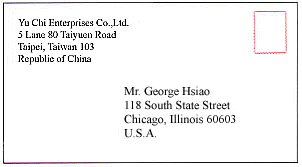Return to Week 3
assignments | Return to course home
page
Below are descriptions of three possible ways to address an envelope correctly, numbered 1 through 3 in Chinese. They are followed by examples of addressed envelopes, A, B, and C.
Using words we learned in class for positions on the envelope, types of addresses, types of numbering and lettering, etc., figure out the following:
1. In each description of possible ways to address an envelope correctly, where is information found about whether the address style is suitable for domestic vs. international mail -- is it at the beginning, middle, or end of each description?
2. In the descriptions, which is always mentioned first: the sender's address or the recipient's address?
3. In which description (1, 2, or 3) is the position of the stamp NOT mentioned?
4. Match each description to one of the pictures: A, B, or C. ("1=C", etc.) Use clues! Once you have matched them, write three pieces of evidence from each description that provided proof for the identifications.
5. What classical Chinese word is used as the verb "to write"? You are used to it as a noun for a certain "written" object. (It is sometimes used alone, sometimes in combination with "xie3".)
6. What classical Chinese word is used for "at" / "on" / "in"? (For instance, "The recipient's address is written in the center"?)
7. What classical Chinese word is used for "and"? (Hint: Look in description #3: "The recipient's name, address, AND postal code...")
8. What classical Chinese word is used for "inside"? (Hint: Look in description #1: "...written neatly in Arabic numerals INSIDE the red boxes at the upper right-hand corner.")


